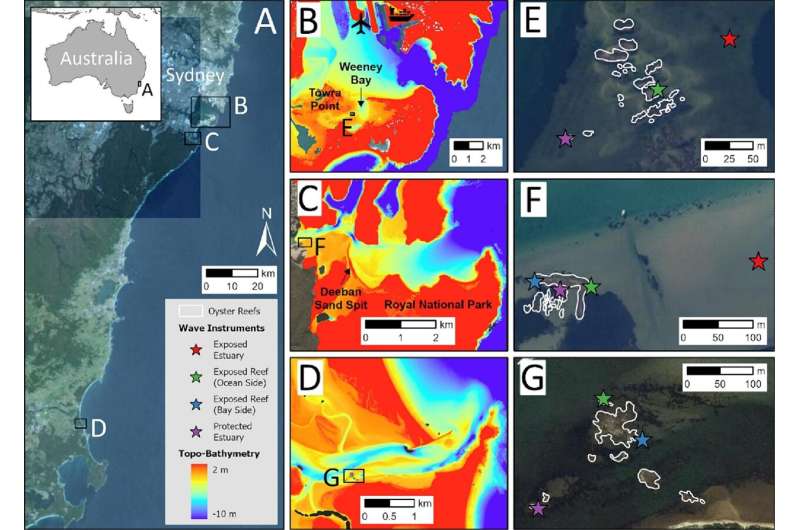This article has been reviewed according to Science X's editorial process and policies. Editors have highlighted the following attributes while ensuring the content's credibility:
fact-checked
peer-reviewed publication
trusted source
proofread
How three tenacious reefs can help restore global oyster populations

Researchers at the University of Sydney have revealed how our oyster reefs can provide lessons on reef restoration projects. More than 85% of naturally occurring oyster reefs have been lost in recent decades due to disease, overharvesting, global warming and pollution. Three reefs that have maintained their oyster populations naturally are in New South Wales, Australia: Gamay (Botany Bay), Port Hacking and Crookhaven (on the Shoalhaven).
Scientists from the University of Sydney and the Sydney Institute of Marine Science (SIMS) have studied these oyster havens to find out what has sustained their populations and how lessons from the reefs can be applied to reef restoration projects.
They found reef restoration must consider local wave and tidal impacts, reef shape and orientation. Each site can then maximize oyster sustainability, provide habitats for grasses, and act as coastal protection from storms and erosion.
The study has been published in Geomorphology.
Author Professor Ana Vila-Concejo from the School of Geosciences at the University of Sydney said there is no one size fits all when it comes to oyster restoration.
"It is vital that reef restoration considers local factors. Different locations need different sized reefs and varied design. This can also help mitigate the erosion processes caused by urbanization," she said.
"As well as helping to satisfy the demand for oysters as food, these reefs are an important barrier that can protect coastlines from erosion and storm damage."
Reef restoration
With the global market for oysters estimated at more than $US8 billion a year, reef restoration is booming. New York City alone is spending millions of dollars on an oyster restoration project to regrow a billion oysters by 2035.
In Australia, the federal government has funded the country's largest restoration project, Reef Builder, to recover shellfish reefs throughout the country. Many restoration projects are under way in Noosa (Queensland), Gamay (Sydney), Port Phillip Bay (Victoria), Glenelg (South Australia), Albany (Western Australia) and the Swan-Canning estuary in Perth (Western Australia), making the timing of the study highly relevant.
Geoscientists refer to the "ecomorphodynamics" of a site to understand how the geophysical structure of a reef, combined with impacts from ocean and tides, affect the ecology of the overall structure.
Lead author of the study Francesca Roncolato, a graduate of the Master of Marine Science and Management program, said, "The totality of these dynamics has important implications for oyster reef restoration. By understanding the natural success of the three reefs we studied, we can apply that knowledge to the placement and design of restored reefs.
"As geomorphologists we know not all coasts need protection. In some places, coastal protection can be detrimental," she said.
"For instance, putting artificial barriers in front of a small sandy estuarine beach could inadvertently reduce the wave and tidal energy levels required to maintain the beach. This could turn a lovely sandy waterfront into a mudflat."
Three types of oyster reef
Professor Vila-Concejo said that the three reefs studied displayed distinct shapes: patch reefs, string reefs and fringing reefs.
"Oyster reefs display a continuum of shape and orientation. But we can see three general morphologies," she said.
Patch reefs, like the one at Crookhaven, are generally aligned at right angles to the tidal currents and incoming waves. String reefs, like the one at Gamay, are more like broken-up barriers, obliquely aligned to tidal flows. And then there are fringing reefs, like the one at Port Hacking, which act as barriers with the lowest energy impact from tide and ocean waves.
Professor Vila-Concejo said, "Our findings are important to inform future reef restoration under increasingly severe climate change conditions to optimize the ecosystems of restored oyster reefs; it is clear that we need more geomorphology input to include ecomorphodynamics in restoration design."
More information: Francesca Roncolato et al, Ecomorphodynamics of oyster reefs and their influence on oyster reef morphology, Geomorphology (2024). DOI: 10.1016/j.geomorph.2024.109213
Journal information: Geomorphology
Provided by University of Sydney




















